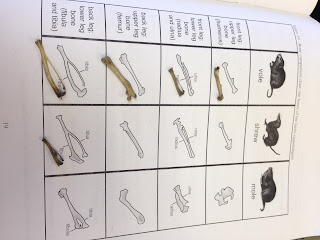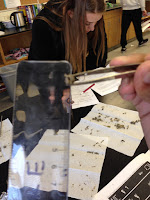In this lab, we did a dry dissection of a barn owl's pellet. The pellet is formed from all of the indigestrible materials obtained when a owl eats. It compacts all these indigestible materials, like bones and feathers, and regurgitate them. Since an owl's diet primiarily consists of small rodents such as mice, voles, and shrews, we hypothesized in the beginning that we would get one of those animals.
 |
| Pellet Mass: 10.72g Length: 6.5 cm Width: 3.3 cm Heigh: 2.4 cm |
 |
| Pellet next to ruler for scale |
Inside of our owl pellet, we think that we had two small rodents: a vole, and a shrew. When we compared the bones that we found and measured them, we found two different sizes of bones and leg bones. Two of the bones were the size of a vole, but then the other one was slightly smaller and had a different end than a vole leg bone, making it a shrew. In addition, we found two bones that came together to form a complete shrew pelvis, confirming what we suspected: that there were two animals in the pellet. Since voles are larger than shrews, we measured each of the bones and categorized the larger and thicker ones to the vole and the smaller and skinnier ones (especially the extra leg bones) to the shrew. The average size of the vole's leg bones was about 15 cm long, and the average size of the shrew was about 10 cm.
 |
| Comparison of bones |
Compare/Contrast to Humans:
 |
| Comparison of Human and Shrew Pelvis |
The pelvis of a shrew is more elongated than a human pelvis. The ischium loops are much bigger, and rather than being round they form a oval shape and the other bones stick out from the ischium to make a dagger-like shape, which the human pelvis does not have. The pelvis also seems to be broken into two parts, although that may also be from the barn owl digestion. Both pelvis's have the same ischium loops, albeit in different lengths, and come to support the hips and attach to the legs with the same sort of joints. Although humans and voles walk in different ways, the pelvis still attaches to the femur in roughly the same way.
 |
| Mandible Comparison |
The jaw of the vole differs from the jaw of the human as well. A human's mandible is more U-shaped, while the jaw of a vole resembled more of a V-shape and is sharper. The teeth of a ole are also sharper as well, with the only "sharp" teeth in the human mouth are the canines, and even then it doesn't reach the sharpness of a vole tooth. The difference is tooth structure signifies the difference between diets of the human and the vole as well. Both the mandible from the humans and the voles hinge to the skull/cranium/maxilla area, and are connected with the same type of joints that allow the crushing and grinding motions needed to start the digestive process.
In a human leg, the tibia is the load-bearing bone and is larger and thicker than the lateral fibula. However, in a vole, the opposite is true. The fibula is thicker than the tibia, suggesting that the fibula is the load bearing bone opposed to the tibia. The tibia and fibula are also fused together into one bone, while in the human skeleton, they remain as two bones. However, in both skeletons, the flared ends of the bones are there, the epiphyses area, which is where the bones attach to the other bones, either the patella or the talus. It is also clear in both structures that the bones are used for the same purpose of movement, although they have different load-bearing bones.
 |
| Another picture of vertebra |
 |
| One of the vertebra we found in the pellet |

No comments:
Post a Comment